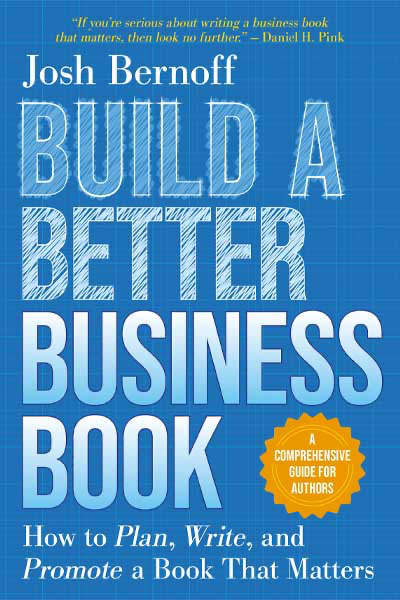
Today’s post is excerpted and adapted from the recently published Build a Better Business Book: How to Plan, Write, and Promote a Book That Matters by Josh Bernoff (@jbernoff).
Negotiation expert Fotini Iconomopoulos described writing chapters for what was to become her bestselling book Say Less, Get More, as “a soul-crushing experience.”
“If you ask me to talk about negotiation, I can riff about it for hours,” she told me. “But as soon as I am sitting down at a computer, a lot of imposter syndrome creeps in. There is a mental barrier that makes me not want to put things on paper.”
She sounds like a lot of the writers I work with. Why do so many writers get blocked, or find themselves writing in circles?
Let’s consider this on a chapter level
If you sit down to write and find that you can’t, the typical reason is that you don’t know what to write. And you don’t know what to write because you don’t know what job the chapter is supposed to do.
Each chapter should answer a question for the reader. Even if you’re blocked, you surely can write that one question.
Then create a reader objective. Write the objective in this form: “After reading this chapter, you will be able to…”
For example, in Iconomopoulos’s negotiation book, the question Chapter 5 answers is, “How does the power balance between parties affect negotiation?” And the objective she might have written looks like this: “After reading chapter 5, you will be able to assess the power balance between yourself and your negotiation partner, and maximize your own power to improve your negotiating position.”
Write the question and the objective, and you’re almost ready to write without pain. All you need is a fat outline.
Writing a fat outline
Among 172 published nonfiction authors that I surveyed, 47% said organizing content was among their biggest challenges. The solution to organizing content is what I call a fat outline.
In contrast to the outlines we all learned in school—which are easy to write, skeletal, and useless—a fat outline has real substance to it. It’s basically a list of all the bits and pieces that will make up the chapter, in the order in which they’ll appear. Fat outlines are relatively easy to create, and essential to easing the task of writing.
To create a fat outline, first assemble all the ingredients that belong in your chapter. There are five basic elements of which all nonfiction book chapters are constructed:
- Ideas and frameworks
- Stories (case studies and examples)
- Argumentation (reasoning)
- Proof points (data, quotes, citations)
- Advice (how-tos)
Based on all the research you did and all the knowledge you’ve assembled so far, you’ve got a collection of this stuff, either in the form of research notes and interviews or perhaps as a partly formed idea or three in your head or something you wrote before. Now is the time to collect it all together.
Open a file and dump inside what you’ve got for this chapter, including all five elements. To keep the size manageable, don’t dump entire hunks of research, just put a sentence or two to remind you what you have. Don’t worry about sentence fragments or grammar—this is just a set of notes that no reader will ever see.
Now arrange the bits to form a story. That might sound challenging, but it’s not as hard as you might think. For example, this is one typical way to arrange a chapter:
Here’s a story of someone facing a problem (case study). You can learn from what they learned (main idea). Here are the elements of that idea (framework). Here’s why that idea is valid and convincing (argumentation, supported by proof points). Taken together, here’s what that all means (idea, restated as conclusion). And here is what you should do about it (advice).
Replace each of those sentences with actual content you’ve conceived, collected, or plan to create and you have a fat outline: a blueprint for the chapter. For a longer chapter, you may have multiple sets of ideas, arguments with proof points, and advice, or even additional case studies, but the fat outline is still going to be just a page or two, so assembling it won’t be a difficult or time-consuming effort.
Making a fat outline is a low-stakes, low-stress activity. You can whip one up in an hour or less. And it’s pretty much immune to writer’s block, because writing down little notes and moving them around doesn’t tap into the “people will be reading this, what if it sucks” anxiety of imposter syndrome. You can mangle grammar, misspell words or include cryptic things that only you understand. Since the plan is only for you, you can include anything that reminds you what the pieces mean including pasted-in graphics, small chunks of prose, or links to web content you’ve researched. Fat outlines are easy to play around with and rearrange, just a matter of moving a few scraps of text here or there, or adding or deleting a few things. They remind you of all the pieces you have, so you won’t forget anything when it’s time to write. And when you put things in a logical order, they define a storyline for your writing.
I have one more tip about the fat outline and the chapter that will emerge from it. Your temptation will be to start with an introduction of the idea. But consider starting with a case study, plunging people immediately into a narrative. People love stories. They will absolutely read that story to find out what happened. And after the story, in the warm glow of the story’s happy (or tragic) ending, your reader is primed to believe virtually anything you say. This is where you tie the story to your main idea. Romanced by the story, the reader then falls for your idea, and your chapter is off and running.
Now write the chapter
With the fat outline in front of you, “just write” is no longer terrifying. Write the opening story. Write the powerful main idea of the chapter. Then write the rest of the bits you’ve mapped out in the fat outline. This is easier because you’ve divided the chapter into tractable tasks. If you have 45 minutes, write out an argument. Or take an hour or two and write a section summarizing secondary research. You don’t even have to write these pieces in order. You can just flesh out the fat outline into text and you’ll have written a draft of a chapter. And don’t worry too much about whether each word and sentence is perfect; you can always improve it in the next stage of revision.
The fat outline is a scaffolding to guide and support you, but you don’t have to slavishly follow it. You might decide to put things in a different order than the outline suggests, or add or delete sections. Nobody will know you didn’t exactly follow the outline. It’s just there as an aid to getting words down on the page.
And remember, you have many more tools than sentences and paragraphs. You can divide the chapter up into pieces with section headings and subheadings. Bulleted or numbered lists make sets of items easier to scan. You can use graphics to illuminate concepts or quote whole paragraphs of other work (with appropriate credit and permission, of course). A chapter written with these types of elements will be more approachable on the page and more palatable to readers. It’s less stressful to write by mixing up these elements; it creates a chapter that is more interesting to read as well.
Now you have a plan for writing your chapter. Start with a reader question. Define an objective for the reader. Assemble your content into a fat outline. Then flesh it out. As Iconomopoulos later remarked, this method “would have saved me months of excruciating rewrites.”
Writing chapters doesn’t have to be painful. You just have to approach it systematically.

Josh Bernoff works closely with nonfiction authors as an advisor, coach, editor, or ghostwriter. He has collaborated on more than 45 nonfiction books. He was formerly Senior Vice President, Idea Development at Forrester, where he spent 20 years analyzing technology and business. Josh has a mathematics degree from The Pennsylvania State University and studied mathematics in the Ph.D. program at MIT. He lives with his wife, an artist, in Portland, Maine. To learn more, visit bernoff.com.


Would you consider self-help to be in the category of business book? looks like it would. Thanks.
While editors/agents consider these separate categories, I’d say you go about writing them in very similar ways—and Josh’s method would apply if you like it.